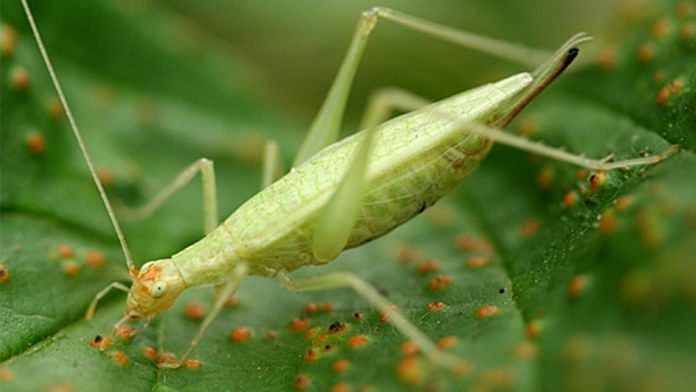New Delhi: Rohini Balakrishnan, a scientist at the Indian Institute of Science (IISc) in Bengaluru, has dedicated her life to opening the world’s ears to the diverse sound of crickets. And now, two new species of crickets — in India and Mexico — are being named in her honour.
Nancy Collins, a US-based citizen scientist who works on crickets, discovered a new species in Mexico and decided to name it Oecanthus rohiniae, after Balakrishnan.
While Collins has not directly worked with the IISc professor, she said, “I have, however, corresponded with her with questions regarding tree crickets, particularly Indian species. She has generously taken time to answer my questions.”
She added that whenever someone reads about Oecanthus rohiniae in future, she hopes it will be a gateway into Balakrishnan’s work.
Similarly, Manjari Jain, a former PhD student of the Indian scientist, also found a new species in India and decided to name it after her former advisor.
While working on a genus of field crickets known as Teleogryllus between 2015 to 2017, Jain and her team discovered a new species in Kerala. They have decided to name the species Teleogryllus rohini.
Jain told ThePrint that a research paper on the Teleogryllus rohini is yet to be published but their collaborators at the Muséum national d’Histoire naturelle (National Museum of Natural History) in France have confirmed that it is a new species.
Also read: These roundworms have no eyes, yet can ‘sense’ blue colour and scamper from it
Mexico’s Oecanthus rohiniae
Oecanthus rohiniae, the new cricket species discovered in central Mexico, dwell in the tropical deciduous forest. As of now, researchers have not found the cricket in any other location.
“This tree cricket is similar to a species found in the US — Oecanthus fultoni — but the number of pulses in each chirp has unique differences,” Collins told ThePrint.
“Oecanthus rohiniae often has a 2-2 or 2-3-2 (chirp) pattern, while Oecanthus fultoni does not. We believe there are at least three more undescribed chirping species of tree crickets in Mexico,” she said.
Collins added: “Analysing these songs might one day provide insight into the evolution of tree cricket songs.”
The US-based scientist has been involved in naming several new species after researchers who have contributed to the understanding of tree crickets.
Also read: This discovery of 29 ‘new’ mosquito genes could open door to curbing malaria spread in India
Becoming a crickets expert
According to Balakrishnan, who has been studying crickets since 1996, this is the greatest honour she could have received.
“I had always been interested in animal sounds and communication, and used to do field trips on my own, but opportunities to pursue these interests professionally came fairly late in life for me,” she told ThePrint.
Balakrishnan completed a Masters in Zoology and a PhD in genetics before she realised that she wanted to work on something that she was passionate about.
“So I applied for postdoctoral positions in the areas of animal navigation and communication, and the lab in which I was successful (at McGill University) studied cricket communication and acoustics,” she said.
“Once I started working with crickets, I realised that they were such interesting animals and also provided a great system to ask many exciting scientific questions,” Balakrishnan added.
The Indian scientist and her students have worked on different aspects of acoustic signalling and communication in insects and birds for the last 15 years. From how crickets mate to sound indicators of birds that can reveal clues about the avian diversity, Balakrishnan has been involved in studying and documenting several species across the country.
By precisely documenting the sound of different species of crickets, Balakrishan hopes to develop a system that will allow researchers to monitor cricket species without having to physically trap and observe them.
She has also discovered several new species of crickets including Prozvenella bangalorensis at the IISc Bangalore campus.
“Each species of cricket has a unique song and documenting their songs allows us to identify them and develop rapid, non-invasive methods of biodiversity monitoring using their sounds. One can easily recognise and count the numbers of species at a site and, for calls that we can hear, we can even count numbers of individuals. This kind of monitoring could be developed for all animal groups that produce distinct sounds, such as crickets, cicadas, frogs, birds and mammals,” Balakrishnan told ThePrint.
Research on crickets
According to Balakrishnan, the research around crickets is also important due to the biodiversity crisis worldwide.
“Given the current biodiversity crisis and the need for rapid monitoring, documenting calls of crickets and other animal groups takes on a special importance, especially in highly biodiverse tropical countries such as India,” the scientist said.
Since crickets are nocturnal, a cricket researcher’s ‘day’ typically begins at dusk when crickets start calling, said Balakrishnan.
“We usually set out early in the evening, with all our recording instruments, so as to be at the site by dusk. We work at a variety of sites, from urban settings such as our own campus, agricultural fields and plantations, and in rainforests,” she added.
Once at the site, researchers wait and listen for the cricket calls to start. They then locate individuals and ascertain the identity of the cricket, using red light from a head-lamp to observe it.
“If it is an unfamiliar species, or we need to get morphological details or mark individuals, then we subsequently catch them. All of this is of course easier said than done! We usually work until 11 pm, when cricket activity dies down,” she said.
(Edited by Rachel John)
Also read: ‘Silent’ Himalayan salamander surprises filmmaker duo with mating call, ‘ballet dance’



